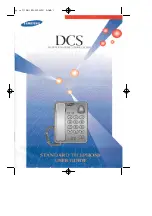
AMT/PTD/PBX/0020/2/4/EN
01/2007
Page 53
2.6
Functional description of M90x, M910 and M92x mobile
terminals
An NeXspan C/S/L/D or NeXspan 50 or NeXspan 500 PBX manages terminal mobility with the
following functions:
Authentication
Mobile authorization procedure. The decision to initiate the procedure is controlled by the PBX.
Each mobile has:
•
an authentication code (AC) programmed on the mobile by the user and calculated by the
PBX. It is only used for the initial authentication.
•
a user authentication key (UAK) which is generated automatically. It is used for all
subsequent authentications.
Authentication is performed by a specific DECT algorithm (DSAA).
The authentication procedure is activated in the following cases:
•
when the mobile registers,
•
after receiving n successive calls (n is a system parameter, default value: 10).
Right of access
In the case of a single site limited to 32 cells, with no company / department restrictions, the
PARI loaded in each base station is used for right of access. The PARK loaded onto each set is
the same as the PARI (y=32). To avoid locking onto a base station on which it is not authorised,
the mobile possesses the PARK{y} information item, containing the first y significant bits of the
ARI (PARI or SARI) used to encode the right of access. This information is loaded into the mobile
when it registers.
When a mobile roaming request is made, the mobile receives the LAL which allows it to
determine whether a roaming change declaration is necessary during reception of a new base
station.
Mobile identification
Each mobile has an IPEI (terminal serial number) and an IPUI. The IPEI is comprised of the
EMC (16 bits) and the PSN (20 bits). The IPUI contains 2 fields - PUT and PUN. The PUT
defines the user type. Normally, type "O" is entered for this field. The PUN is the directory
number of the set coded in BCD, with "F" added to the left of the digit string. It is entered in the
mobile when the latter registers.
Subscription
Subscription is the registration of a mobile’s call processing features.
Location
Roaming is the procedure by which a mobile locks itself to the authorised base station emitting
the best signal. The terminal decides to change base station via the "Roaming" or "Handover"
procedures.
A mobile set can be in standby mode (standard status: detach) in which case it is considered to
be non-located. Initiating a call from the set automatically takes it out of this mode and maintains
it in located state.
Содержание NeXspan 50
Страница 2: ...Page 2 01 2007 AMT PTD PBX 0020 2 4 EN ...
Страница 20: ...Page 20 01 2007 AMT PTD PBX 0020 2 4 EN ...
Страница 66: ...Page 66 01 2007 AMT PTD PBX 0020 2 4 EN ...
Страница 70: ...Page 70 01 2007 AMT PTD PBX 0020 2 4 EN Figure 4 2 Bottom view of the LD4 ST card ...
Страница 134: ...Page 134 01 2007 AMT PTD PBX 0020 2 4 EN ...
Страница 160: ...Page 160 01 2007 AMT PTD PBX 0020 2 4 EN ...
















































